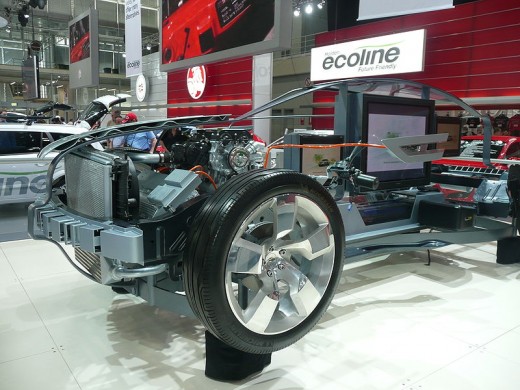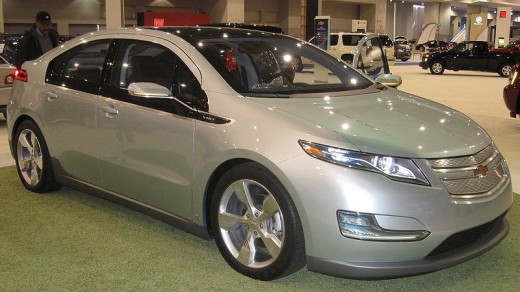Future Car - Chevrolet Volt


Chevrolet Volt
The Chevrolet Volt is a range extended electric that can be plugged into a standard wall outlet (120V). The vehicle to be produced by the General Motors Chevrolet division. It is expected to be launched as a 2011 model.
Volt's drive system is based on GM's new Voltec (formerly known as E-Flex) platform. This system uses lithium-ion batteries which are charged by a standard one-hundred twenty (120/240) / two-hundred forty volt house outlet or by the on-board gasoline engine. The gas engine is capable of producing 16kWh (kilo Watt hours). Electric power driving the vehicle is drawn from its on-board lithium-ion batteries which are charged by an electrical power outlet and/or the gasoline engine.
The Volt's 16 kWh (8.8 kWh usable) lithium-ion battery pack can be fully charged by plugging the car into a residential electrical outlet using the provided charging cord. As such, no external charging station will be required. Unlike most current commercially available electric hybrids (Honda Insight & Toyota Prius), propulsion of the Volt is exclusively handled by the electric
motor with the gas engine or electrical outlet recharging the batteries.
Using this concept any type of recharging source can be used that fits within the car without modifying the final drive train. This is very similar to Ford's HySeries concept.
When the battery pack is fully charged the Volt is capable of traveling forty (40) miles without any assistance from the gasoline engine. With commute distances equal to or less than forty miles round-trip the Volt is truly an electric vehicle.As research indicates that 75% of car drivers commute less than thirty-four (34) miles per day, Volt is potentially an electric only vehicle for most consumers.
Should the Volt be driven more than forty miles a small gasoline engine (71 horse power) will automatically start, run a generator, and thus extend the auto's range by three-hundred (300) miles. All of this is handled by an on-board computing system which will either route the generated power directly to the drive motors or into the battery pack. There is no direct drive from the engine to the drive wheels unlike Prius or Insight.
Drivetrain

Voltec Drivetrain
Voltec (formerly E-Flex) is a General Motors designed power-train scheduled for release on the Volt in late 2010. The design uses a battery-dominant, plug-in capable, series storage cell architecture.
Voltec vehicles are all electrically-driven, feature common drivetrain components, and will be able to create electricity on board using either a gasoline engine, fuel cell, or regenerative braking. This is a departure from the design standard incorporated in hybrids built by Honda and Toyota.
As the current Society of Automotive Engineers (SAE) definition of a hybrid vehicle specifies that the vehicle shall have "two or more energy storage systems both of which must provide propulsion power, either together or independently", GM has avoided the use of the term "hybrid" when describing its Voltec designs. Voltec propulsion power is supplied solely by the on-board batteries. GM describes the Volt as a range extended electric vehicle.
EPA Standards Issues
General Motors is currently disputing United States Environmental Protection Agency methods of testing in regard to the Volt. The EPA reportedly wants to alter the method of testing currently used for all other hybrid vehicles. If assessed with the same EPA tests used by other hybrids, the Volt's ability to use the energy stored in the batteries would result in it achieving a fuel economy rating of over 100 mpg, which would make the Volt the first mass-produced automobile to achieve such a rating, therefore it is in GMs best interest to retain current EPA standards of testing.
General Motors believes that altering the current EPA hybrid testing methods would be unfair and would not recognize the fact that the car can travel an estimated 40 miles (64 km) on battery power alone. Of course this change in standard would affect the Volt's mileage ratings.
For this reason emissions figures are unavailable (or in dispute), though the potential for reduced emissions is quite clear. After all, a vehicle that runs on battery power only, produces no emissions from the car itself and a variable amount of emissions (depending on night or day recharging) from the power plant supplying electricity.
Retail Pricing
At an "over the curb" price of $40,000.00* General Motors does not expect to make a profit on the Volt. Should the Volt prove popular and the line be a viable product for a number of years, economies of scale dictate a price decrease over the years. However, GM is being cautiously optimistic about the Volt neither touting it as a replacement for existing lines nor playing it off as a one-off experiment.
* I occasionally hear $30,000 which is a quite a price drop from $40,000. Not sure why this is.
This is the third in a series of articles on the future of the car. Please see links below for earlier articles.
Future Car Series
- The Future of the Car
The car of tomorrow promises to be radically different than what we are driving today. Pardon the Science Fiction wording please.There are many reasons for these advances; Computing and programming A... - Future Car - Ford's Hydrogen I.C.E.
I.C.E. stands for Internal Combustion Engine. Ford is currently looking at creating a car that will bridge the gap between gasoline power and the very likely future fuel; hydrogen. - Future Car - Chrysler EV Series
EV stands for Electric Vehicle. Much to everyone's surprise Chrysler recently unveiled an all electric vehicle called the Dodge Circuit EV. The Circuit will be an all electric sports car vaguely reminiscent... - Future Car - The Problems with Hydrogen
Hydrogen is the lightest element in the periodic table and the first listed. It is a colorless, tasteless, odorless, non-metalic gas that is highly flammable. Hydrogen can be ignited in an air (or oxygen)... - Future Car - Toyota / Honda
Sorry to join these two models in one hub, but neither company (Toyota or Honda) has a lot to say about the new models. Toyota in particular won't say anything about the upcoming Prius, but rumors abound. ... - Future Car - Subaru
Subaru is the western spelling for the Japanese word for "Pleiades." This is readily apparent looking at the Subaru logo/badge. Subaru is a division of Fuji Heavy Industries (FHI) and the word Subaru itself... - Future Car - Peugeot / Citroën
Peugeot and Citroën is now known as Peugeot Citroën. The companies are now combined though each is marketing and selling it's own particular models. If Citroën continues as a viable company remains to be... - Future Car - Opel
Opel, in coopreation with General Motors, has introduced the Ampera (or is it Flextreme?) as a diesel plug-in series hybrid concept car. It can travel thirty-four (34 mi) miles on its lithium-ion battery...










